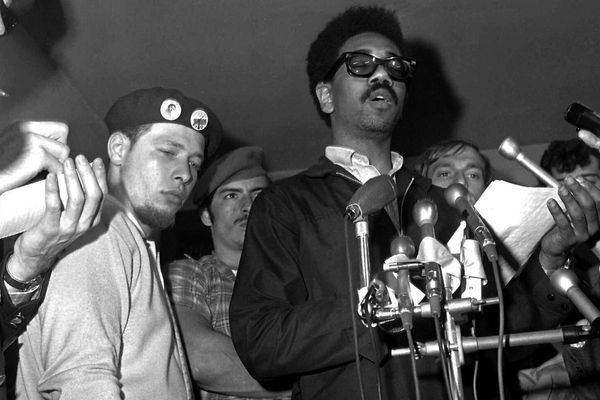
When police found a kindergarten boy who had walked off from school after attacking his teacher and classmates, it didn’t take them long to start guessing about the cause of his behavior.
“He’s bad because no one’s correcting it,” one of the officers who brought the boy back to school is seen saying on police body-camera footage of the incident, which took place in Silver Spring, Maryland, in 2020.
The officers asked the boy if he got spankings at home – and later told his mother she should beat him.
But when I first saw the video, I knew this case was much deeper than just one of a boy being bad or playing hooky from school. As an expert in behavioral health, child trauma and school safety, I can see from the video that the boy is likely experiencing emotional and psychological distress before the officer speaks with him. His behavior, posture and voice – hanging his head low, shoulders hunched and murmuring – indicate something is wrong.
The police seem indifferent, and when school officials get involved later on, they also don’t take steps to address what is, to me, clearly a child’s mental health emergency. To me, this is a case that typifies the uneven and heavy-handed ways that police respond to school kids in crises. These responses disproportionately lead to arrests of Black and Hispanic children.
To a trained person, a more thoughtful response to the 5-year-old’s distress would have included speaking to him in a respectful and helpful way. For example, the Pediatric Emotional Distress Reference System uses the method called “engage, calm and distract” to respond to a child in crisis. Yelling at and berating a child, particularly during a crisis, is likely to escalate the behavior and may cause long-term psychological damage.
Instead, the officers referred to the boy as a little “beast,” a “violent little thing” and a “fool” who needed to be put in a “crate.”
Conflicting messages
I can also see from the video that the boy’s mother is likely distressed trying to help her son and not lose her job in the process of constantly having to come to the school for his misbehavior. To someone who is properly trained, a response that prompts the suggestion to contact a local family agency to receive crisis services and a behavioral health referral is warranted.
On the video, she states that she overheard one of the officers ask, “What’s going on at home?” when she was contacted by phone to calm her son down. Not long after she showed up at the school, she removed her son’s shirt to reveal his bare back in order to prove to the officers that she wasn’t physically abusing the boy.
“We believe it’s the exact opposite,” a male officer says on the video.
“Yeah, we want you to beat him,” a female officer chimed in, the video shows.
Both of the officers were Black, as were the mother and her son.
But the mother explained that on a previous occasion, she had said that she would beat her son when they got home – and school officials who overheard had warned her that they are mandated by law to report even the possibility of child abuse to state officials.
The police, meanwhile, assured the mother she can hit her child. The video shows a male officer saying, “As law enforcement officers … you can, most definitely – as a matter of fact we applaud the fact that you will please beat your kid.”
Then one of the officers placed one cuff on the boy’s tiny wrist with his hands behind his back to demonstrate what will happen if he doesn’t learn to control his behavior.
“You know what these are for?” the male officer asked the boy. “These are for people who don’t want to listen and don’t know how to act.”
Costly consequences
In the end, it wasn’t the mother’s actions, but those of the police officers, that were questioned. The mother filed a lawsuit on behalf of her son. The case was settled in August 2022 for US$275,000. Of that amount, $220,000 was ordered to be paid on behalf of the two officers who were seen in the video berating the boy, and $55,000 on behalf of the school system. The money will be put in a trust that the boy can access as an adult.
Without the video, it’s hard to see how the case would have resulted in a settlement of any sort. It would have boiled down to a troubled 5-year-old boy’s recollection versus the memory of several adult authority figures.
But there was a video. And it captures how fraught the encounter between the boy and the police officers was from the very start.
“Why are you out of school?” the male officer asks the boy after finding him near a car several blocks away. “Are you an adult?”
He proceeds to say, “Get back over there now!” and grabs the child by the arm. The officer asks whether the child has been hurt and says he needs to return to school. At this point, the boy begins to cry and say, “No, no, no,” to which the officer responds, “Get in or we are gonna have problems … you are bad … this is why people need to beat their kids.”
Challenging behaviors
If police and educators don’t figure out better ways to respond to children in crisis, I predict they will face similar legal actions like the lawsuit they faced in the Maryland case.
More and more police departments are being required to ensure that their officers wear body cameras. And it is inevitable that officers will have encounters with children and families in crisis.
Adults often have trouble responding in helpful ways to children with challenging behaviors.
But there are several evidence-based approaches to dealing with a child in crisis that are likely to be more effective than the heavy-handed approach taken with this boy. Examples of evidence-based approaches include assuring the child that he is safe, reassuring the child that he does not need to feel guilty or bad about any feelings or thoughts, and seeking the help of a trained professional.
In situations where a child’s behavior is aggressive or harmful, pediatric psychiatric experts recommend de-escalation techniques such as respecting personal space, avoiding provocation, setting clear limits and offering choices of possible actions.
Many school staff are trained in these methods, including through a program I developed with a colleague.
Similar training programs exist for police officers, especially those who work in schools. But most states do not require even police permanently stationed in schools to receive specialized training on how to handle youth in crisis.
In addition, there’s not much guidance on what educators should do – or whom they should call – when police respond poorly to a young person in crisis. On the one hand, an educator could have intervened, questioning the officers’ use of force and even calling for a police supervisor to consult with. But it’s also reasonable that a teacher or principal would defer to an officer of the law.
Leaving the school was definitely unsafe for the 5-year-old boy. But it was not appropriate for police to berate the boy, threaten him with handcuffs and suggest his mother beating him would take care of the problem. It was also very concerning that educators stood by and let it happen. To me, this situation raises serious questions about how professionals are responding to children in crisis – and about whether police officers are doing more harm than good in schools.
A judge presiding over the lawsuit against the officers said their behavior toward the boy “was assaultive in nature,” The Washington Post reported on September 2, 2022.
The article stated that the two officers involved had been “administratively charged with several counts, including neglect of duty and failure to be courteous.”
“They agreed to the proposed punishments,” the newspaper stated, “and the matter was closed.” The female officer was suspended for four weeks and the male officer was suspended for two weeks, according to newspaper.
Elizabeth K. Anthony does not work for, consult, own shares in or receive funding from any company or organization that would benefit from this article, and has disclosed no relevant affiliations beyond their academic appointment.
This article was originally published on The Conversation. Read the original article.







